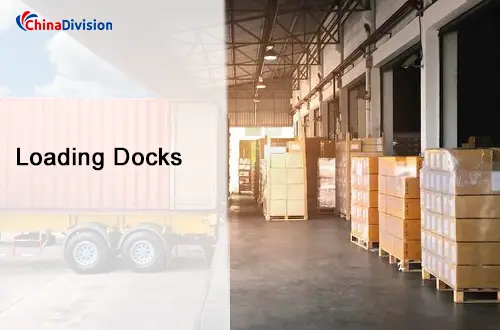How Do Loading Docks Improve Warehouse Efficiency?
As a core node in the warehousing and logistics system, the loading dock's design and operational efficiency directly impact the smooth flow of the entire supply chain. An efficiently operated loading dock not only reduces logistics costs but also improves customer satisfaction and market competitiveness.
Table of Contents
- What is a loading dock?
- Types of Loading Docks and Their Applications
- Loading and unloading docks are classified by function
- How do loading and unloading docks improve warehouse efficiency?
- What factors influence the selection of loading and unloading terminals?
- Frequently Asked Questions and Customer Pain Points
- Chinadivision's Logistics and Transportation Services
As an international warehousing, logistics, and transportation service provider, Chinadivision understands the importance of loading docks in global cargo transportation. This article will detail the types and components of loading docks, as well as how to improve warehouse efficiency by optimizing dock operations. It will also answer in-depth questions users may have and provide professional international logistics solutions for B2B companies and e-commerce sellers.
What is a loading dock?
A loading dock is a dedicated area within a warehouse, distribution center, or factory used for loading and unloading goods. It typically docks with transport vehicles (such as trucks) to ensure the quick and safe transfer of goods. Connecting the warehouse's internal and external transportation systems, it is a key component in achieving efficient logistics. Efficient loading and unloading docks ensure the smooth, timely, and safe transfer of goods, directly impacting warehouse throughput and delivery speed.

Common terms include:
Shipping Dock: The loading and unloading area for shipping goods
Receiving Dock: The area for receiving goods
Delivery Dock: The loading and unloading point for goods delivery
Trucking Dock: The area where trucks dock for loading and unloading
Warehouse Loading Docks: A collection of loading and unloading platforms within a warehouse
Types of Loading Docks and Their Applications
Depending on warehouse layout, transportation methods, and climate conditions, loading and unloading docks can be categorized as follows:
Flush Dock: Flush-mounted in standard warehouses, suitable for standard truck loading and unloading.
Enclosed Dock: Fully enclosed, suitable for cold or rainy regions. Equipped with door seals or shelters, it is suitable for temperature-controlled environments (such as cold chain logistics) to protect goods from the weather.
Open Dock: Unprotected, low-cost but less secure.
Sawtooth Dock: An angled design suitable for sites with limited space. Dock doors are arranged in a zigzag pattern, saving space and improving vehicle turnover efficiency.
Depressed docks
Low-to-ground locations are suitable for specialized vehicle loading and unloading needs.
Drive-through docks
Allow vehicles to pass directly through the warehouse, increasing loading and unloading flexibility and making them suitable for high-frequency transport.
Loading and unloading docks are classified by function:
Shipping docks: Dedicated to loading and unloading goods from the warehouse onto trucks/ships, requiring rapid sorting and loading equipment.
Receiving docks: Responsible for loading and unloading goods into the warehouse, requiring quality inspection and temporary storage.
Trucking docks: Designed for road transport, emphasizing vehicle scheduling and loading and unloading efficiency.
Structurally, they can be classified as follows:
Vertical docks: Suitable for ports with minimal water level fluctuations, facilitating direct mechanical operation (such as container terminals).
Slope docks: Commonly found in inland ports, connecting ships to land via a ramp.
By degree of specialization, they can be classified as follows:
Comprehensive docks: Handle a variety of cargo types (such as breakbulk and bulk cargo) and require highly versatile equipment. Specialized terminals: Designed for a single cargo type (such as oil terminals or coal terminals), they offer high loading and unloading efficiency.
How do loading and unloading docks improve warehouse efficiency?
A well-designed warehouse loading dock can significantly improve warehouse operational efficiency:
Fast loading and unloading: Reduce wait times and increase turnover.
Reduced labor costs: Use automatic levelers and intelligent vehicle restraint systems to reduce manual operation time and minimize errors.
Improve safety: Regular employee training protects both workers and cargo, reduces accidents, and improves long-term operational efficiency.
Optimize space utilization: A rational layout increases storage capacity.
Process standardization: Establish unified loading and unloading procedures (such as dock loading SOPs) to ensure rapid cargo turnover.
Dock scheduling: Use software systems to schedule dock hours and avoid truck congestion. This is commonly seen in delivery dock operations at international logistics centers.
Zoning: Dedicate separate loading and unloading areas based on cargo type (e.g., heavy cargo, light cargo) and transportation method (sea, air) to reduce handling distances. Identification System: Use technologies like color coding and electronic tags to quickly locate and track cargo.
What factors influence the selection of loading and unloading terminals?
Cargo Type and Volume: Large or fragile items may require specialized terminal designs (e.g., enclosed terminals).
Transport Vehicle Specifications: Truck height and width influence terminal dimensions.
Warehouse Space Layout: Warehouse layout and available space will determine the terminal type (e.g., a zigzag terminal is suitable for space-constrained locations).
Climatic Conditions: Determine whether a sealed or enclosed terminal is required.
Operation Frequency: High-frequency loading and unloading requires a higher level of automation, as well as more dock doors and dispatching systems.
Budget: While automated equipment is efficient, the initial investment is high, and long-term benefits must be weighed against this.
Port Conditions: Prioritize ports with sufficient water depth, unobstructed waterways, and a well-developed collection and distribution system.
Hinterland Economy: Proximity to industrial clusters can shorten transportation distances and reduce transit costs.
Service Responsiveness: Consider customs clearance speed, warehousing flexibility, and value-added services (e.g., labeling and assembly). Hidden Costs: Be aware of potential expenses like port congestion charges and demurrage, and choose a service provider with transparent rates.
Frequently Asked Questions and Customer Pain Points
How can cargo safety be ensured during loading and unloading?
Installing vehicle restraints and anti-collision devices, and training employees on proper operation, can significantly reduce the risk of cargo damage. Chinadivision's warehouses are equipped with advanced safety features to ensure the safety of cargo.
What is the difference between a receiving dock and a loading dock?
A receiving dock unloads incoming goods, while a loading dock loads outgoing goods for shipment to customers or other facilities.
How can I choose a loading dock suitable for e-commerce small packages?
For e-commerce small packages, prioritize terminals equipped with automated sorting equipment and supporting multi-channel delivery (such as postal and express delivery). Pay attention to peak handling capacity and return and exchange services.
Does Chinadivision support multi-country delivery?
Yes. Chinadivision has a global logistics network, supporting warehousing and delivery services in North America, Europe, Southeast Asia, and other regions, helping B2B companies and e-commerce sellers expand into the international market.
What are the special requirements for loading and unloading dangerous goods?
You need to select a terminal certified for dangerous goods storage, ensure that packaging complies with the IMDG Code (International Maritime Dangerous Goods Code), and that operators hold relevant certifications.
How can loading and unloading terminals reduce international shipping delays?
Efficient terminal operations minimize truck wait times, expedite cargo processing, and improve documentation accuracy—all of which are critical for timely customs clearance and subsequent delivery.
Chinadivision's Logistics and Transportation Services
As a professional international warehousing, logistics, and transportation service provider, Chinadivision offers end-to-end supply chain solutions for B2B businesses and e-commerce sellers. Our services include:
A global warehouse network: Efficient loading docks support rapid cargo turnover.
Intelligent logistics systems: Real-time monitoring of terminal operations optimizes warehousing efficiency.
Customized solutions: Terminal layout and processes are designed to meet diverse logistics challenges based on customer needs.
If you would like to enhance your international transportation and warehousing capabilities with professionally managed loading docks and logistics services, contact Chinadivision today. We help you navigate the complexities of cross-border logistics with reliable, scalable, and innovative solutions.





